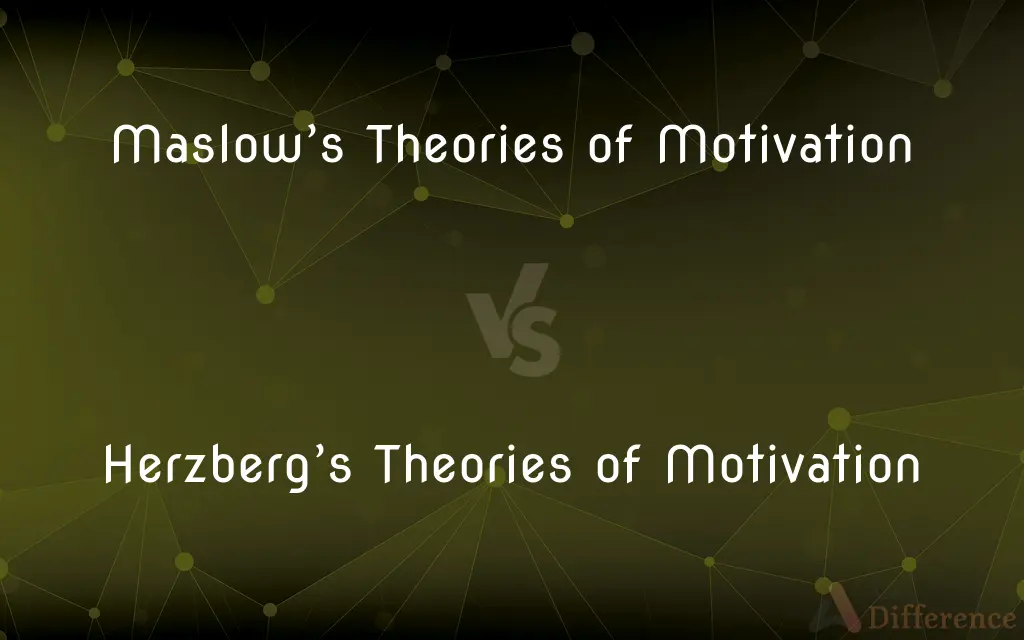Maslow’s Theories of Motivation vs. Herzberg’s Theories of Motivation — What's the Difference?
By Tayyaba Rehman — Published on December 10, 2023
Maslow's Theories of Motivation outline a hierarchy of needs from physiological to self-actualization, while Herzberg's Theories focus on two factors: hygiene (dissatisfiers) and motivators.

Difference Between Maslow’s Theories of Motivation and Herzberg’s Theories of Motivation
Table of Contents
ADVERTISEMENT
Key Differences
Maslow's Theories of Motivation and Herzberg's Theories of Motivation are both prominent frameworks in understanding human motivation, yet they present different perspectives. Maslow's Theories of Motivation propose a hierarchy of needs, suggesting individuals move from fulfilling basic physiological needs to higher-level needs like self-actualization. In contrast, Herzberg's Theories of Motivation distinguish between factors that cause job satisfaction and those causing dissatisfaction.
Maslow's Theories of Motivation encompass five levels of needs: physiological, safety, love/belonging, esteem, and self-actualization. According to this theory, individuals must satisfy lower-level needs before advancing to higher-level needs. On the other hand, Herzberg's Theories of Motivation, also known as the Two-Factor Theory, suggest that motivators lead to satisfaction while hygiene factors prevent dissatisfaction.
Within Maslow's Theories of Motivation, the emphasis is on a progression through various needs, suggesting that higher needs become salient only after the fulfillment of more basic ones. Contrastingly, Herzberg's Theories of Motivation propose that job satisfaction and dissatisfaction operate on two separate continua, implying that improving hygiene factors won't necessarily increase satisfaction, but rather prevent dissatisfaction.
In essence, while Maslow's Theories of Motivation present a broader perspective on human needs and motivation, Herzberg's Theories specifically delve into job-related factors that influence an individual's motivation and satisfaction levels. Both theories, although distinct, offer valuable insights into the diverse factors influencing human motivation.
Comparison Chart
Core Concept
Hierarchy of needs
Two-Factor Theory (Motivators & Hygiene Factors)
ADVERTISEMENT
Number of Levels/Factors
Five levels of needs
Two factors (Motivators & Hygiene)
Focus
Broad human needs from basic to self-growth
Job-related satisfaction and dissatisfaction
Progression
Sequential, from basic needs to higher needs
Two independent continua
Application
General human behavior and motivation
Specifically job and work environment related
Compare with Definitions
Maslow’s Theories of Motivation
A hierarchical structure of human needs.
Based on Maslow's Theories of Motivation, physiological needs come before esteem needs.
Herzberg’s Theories of Motivation
Focus on job-related satisfaction and dissatisfaction.
According to Herzberg's Theories of Motivation, salary is a hygiene factor, not a true motivator.
Maslow’s Theories of Motivation
Progression from basic to complex motivational needs.
Maslow's Theories of Motivation suggest self-actualization is pursued after basic safety needs.
Herzberg’s Theories of Motivation
Emphasis on factors leading to job contentment and discontentment.
Using Herzberg's Theories of Motivation, organizations can strategize to increase job satisfaction.
Maslow’s Theories of Motivation
Model illustrating the evolution of human desires.
Using Maslow's Theories of Motivation, managers can understand employees' motivational drivers.
Herzberg’s Theories of Motivation
Distinguishes between motivators and hygiene factors.
Herzberg's Theories of Motivation identified achievement as a primary motivator.
Maslow’s Theories of Motivation
Framework indicating priorities of needs.
Maslow's Theories of Motivation emphasize the foundational role of physiological needs.
Herzberg’s Theories of Motivation
Two-factor framework for work motivation.
Herzberg's Theories of Motivation suggest improving job conditions may not directly boost satisfaction.
Maslow’s Theories of Motivation
Five-tier model of human motivation.
According to Maslow's Theories of Motivation, love and belonging are mid-level needs.
Herzberg’s Theories of Motivation
Theory targeting specific work-related motivational elements.
Herzberg's Theories of Motivation classify recognition as a potent motivator.
Common Curiosities
What's the main concept of Maslow’s Theories of Motivation?
Maslow's Theories revolve around a hierarchy of human needs, from basic to self-actualization.
Which level in Maslow’s hierarchy corresponds to esteem needs?
In Maslow’s Theories of Motivation, esteem needs are the fourth level, just below self-actualization.
How does Herzberg’s Theories of Motivation differentiate work factors?
Herzberg distinguishes between hygiene factors (preventing dissatisfaction) and motivators (leading to satisfaction).
Are salary and job security motivators in Herzberg’s Theory?
No, in Herzberg’s Theories of Motivation, they are considered hygiene factors.
Which theory, Maslow's or Herzberg’s, focuses more on work-specific factors?
Herzberg’s Theories of Motivation focus specifically on work-related factors.
What is the primary criticism of Maslow’s hierarchy?
One criticism is its linear progression, as needs can often be non-sequential.
Can hygiene factors in Herzberg’s theory lead to job satisfaction?
No, they can prevent dissatisfaction but don't inherently cause satisfaction.
Can an individual pursue self-actualization while basic needs are unmet in Maslow’s theory?
Typically no, according to Maslow’s Theories of Motivation, basic needs must be met first.
How does Herzberg’s Theories view achievement?
Achievement is considered a primary motivator in Herzberg’s theory.
How do Herzberg’s Theories of Motivation view job promotion?
Herzberg's Theories classify job promotion as a motivator.
Is self-growth a part of Maslow’s hierarchy?
Yes, self-growth or self-actualization is the pinnacle of Maslow’s Theories of Motivation.
Can organizations apply both Maslow’s and Herzberg’s theories simultaneously?
Yes, organizations can integrate insights from both to enhance employee motivation.
Are working conditions considered motivators in Herzberg’s theory?
No, they are seen as hygiene factors in Herzberg’s Theories of Motivation.
Which theory is broader in application: Maslow's or Herzberg's?
Maslow’s Theories of Motivation have broader application, spanning beyond just work.
How do Maslow’s Theories of Motivation view social needs?
Social needs, or love/belonging, are the third level in Maslow's hierarchy.
Share Your Discovery

Previous Comparison
Supplements vs. Vitamins
Next Comparison
Interim Dividend vs. Final DividendAuthor Spotlight
Written by
Tayyaba RehmanTayyaba Rehman is a distinguished writer, currently serving as a primary contributor to askdifference.com. As a researcher in semantics and etymology, Tayyaba's passion for the complexity of languages and their distinctions has found a perfect home on the platform. Tayyaba delves into the intricacies of language, distinguishing between commonly confused words and phrases, thereby providing clarity for readers worldwide.












































